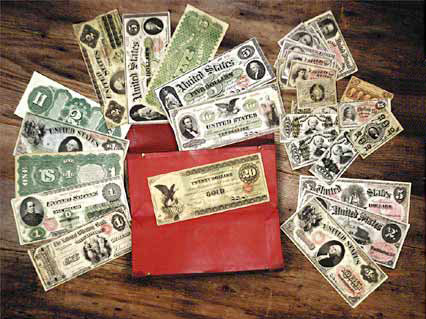About Paper Money

Held by one family for four generations, this collection included a rare 1866 $20 Gold Certificate, along with 64 other large-size and fractional notes.
Collectors with a wide range of interests are drawn to paper money, which offers vibrant color, detailed illustrations, intricate designs and superb typography. Created by some of the nation's finest engravers, paper money has featured illustrations by famous artists, has been printed by prominent statesmen including Paul Revere and Benjamin Franklin, or has been signed by founding fathers whose signatures are found on the Declaration of Independence. Continental Currency recalls the birth of our nation, Fractional Notes and Confederate Currency evoke the Civil War, the last large-size notes remember the First World War and the Roaring Twenties, and Silver and Gold Certificates recall the era of paper money backed by precious metal.
U.S. paper money makes a great complement to U.S. coins in a collection, as both are legal tender. However, paper money adds color, visual interest and the exceptional detail only possible on printed currency. As you discover and explore the different types of U.S. paper money, you'll see how currency notes reflect American art, culture and values through the course of our nation's history.
Articles
- The Changing Luck of the $2 Bill
- Better Than Gold
- Postcards and National Bank Notes
- Snorter Notes
- The 1866 20 Gold Certificate: Held by One Family for Four Generations
- Art and Paper Money
- Civil War Currency and Our Confederate Hoard
- National Bank Notes of Berlin, NH
- Notes Reflect the Great Depression, Part 1
- Notes Reflect the Great Depression, Part 2
- Notes That Went to War
- Rare and Famous Notes

